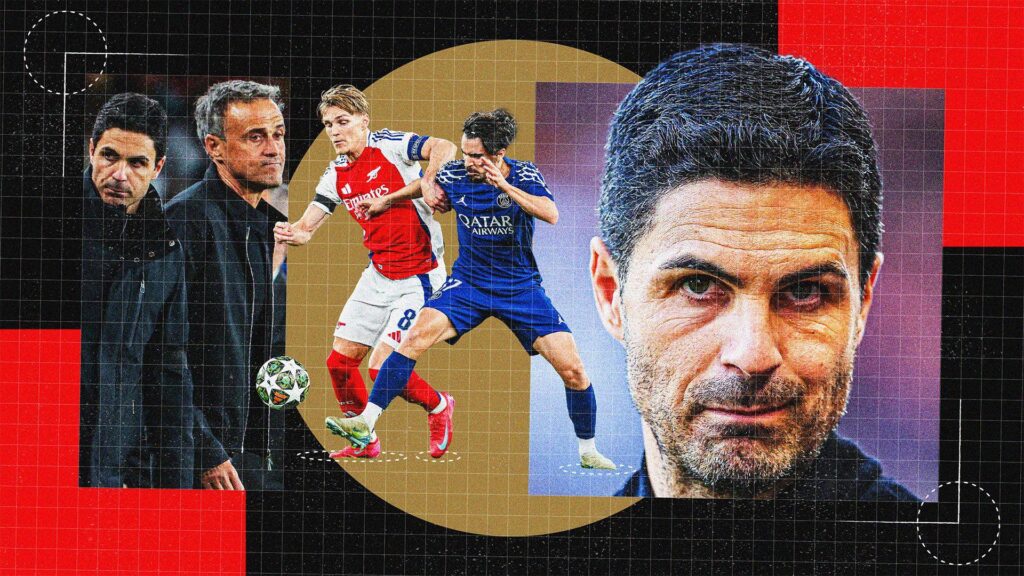The article by Alex Keble explores how Arsenal manager Mikel Arteta can orchestrate a comeback against Paris Saint-Germain (PSG) following a 1-0 deficit in the UEFA Champions League semi-final. Arteta emphasizes the emotional turmoil his team feels, revealing that they will harness emotions like “rage, anger, and frustration” to fuel their efforts on the pitch. The historical context of Arsenal’s previous Champions League performances, including their defeat in the 2006 final against Barcelona, adds weight to the upcoming match, as supporters travel to Paris with hope and anxiety.
In their last seven semi-final matches across all competitions, Arsenal failed to score, losing five and drawing two. Conversely, PSG is also familiar with heart-wrenching disappointments in the Champions League, previously surrendering strong leads and suffering unexpected exits. The tie remains delicately balanced between two sides with their fair share of ghosts.
**1. Tactical Adaptation: The 4-2-3-1 Formation**
One key aspect that Arsenal must build upon is retaining the 4-2-3-1 formation that Arteta utilized in the latter stages of the first leg match. Initially, PSG’s high pressing and fluid transition overwhelmed Arsenal’s setup. The first twenty minutes showcased PSG’s dominance, where they held 77% possession and executed a series of relentless attacks. Arteta’s tactical adjustments midway through the first leg, however, forestalled PSG’s momentum, leading to a more balanced game afterward.
In the second leg, Arsenal must replicate this tactical structure that proved effective. By employing a more aggressive midfield composition, which includes Thomas Partey’s anticipated return, Arsenal can disrupt PSG’s playmakers like Vitinha and Joao Neves, ideally restricting their effectiveness. These changes can unsettle PSG while enhancing Arsenal’s control and counter-attacking capabilities.
**2. Empowering Odegaard and Saka**
Another pivotal strategy will involve encouraging Martin Ødegaard to engage deeper in midfield. While Ødegaard has been under scrutiny for his performance in high-stakes matches, Arteta acknowledges the need for him to interact with the ball more effectively. Moving Ødegaard deeper opens up opportunities for him to facilitate play alongside winger Bukayo Saka, enhancing their attacking synergy.
A notable contrast can be drawn between Ødegaard’s positional influences in the first leg against PSG and in Arsenal’s overwhelming win against PSV Eindhoven, where he thrived while receiving the ball lower down the pitch. His tactical positioning should amplify Arsenal’s ball distribution, ultimately supporting a more offensively dynamic setup.
**3. Channeling Bravery and Aggression**
The third strategic insight drawn from Aston Villa’s impressive comeback against PSG in their quarter-final clash suggests Arsenal must embrace a similar spirit of aggression and audacity. Arsenal needs to take calculated risks, hammering forward with intensity to unsettle PSG’s confidence. Historical patterns of PSG retreating under pressure, as seen in previous matches, indicate that a bold approach could yield substantial rewards.
Developing players like Miles Lewis-Skelley to exploit their abilities in one-on-one situations can further develop Arsenal’s tactical repertoire, as this may catalyze opportunities that break down a structurally sound PSG defense.
**4. Maximizing Set-Piece Opportunities**
Lastly, Arsenal’s proficiency from set-pieces should not be underestimated. With 14 set-piece goals in the Premier League this season, and displaying a superior expected goals (xG) tally driven by set-pieces compared to PSG, these scenarios could be crucial in the context of the match. Conversely, PSG has shown weaknesses in defending set-pieces, particularly from corners.
Arteta’s plans should integrate both aggressive attacking play whilst seeking set-piece opportunities to exploit PSG’s frailties, potentially transforming a precarious position into a powerful advantage.
In summary, for Arsenal to successfully navigate their upcoming semi-final clash with PSG and overturn the deficits faced, it’s essential to utilize a blend of solid tactical formations, thoughtful player positioning, aggressive attacking mindset, and maximizing set-piece opportunities. If executed efficiently, these strategies could herald a significant turnaround for Arsenal in their search for Champions League glory.



